Comprehensive Report on Marketing Research Methodologies
VerifiedAdded on 2022/10/19
|13
|5023
|58
Report
AI Summary
This report provides a comprehensive overview of marketing research, beginning with a definition of research and its importance in marketing. It details the marketing research process, which includes problem definition, development of an approach, research design formulation, data collection, data preparation and analysis, and report preparation. The report then classifies different types of research, including pure and applied research, and delves into the marketing research process, outlining its six key steps. It further discusses research design, differentiating between exploratory and conclusive research, and provides an in-depth look at exploratory research methods like focus group interviews, detailing their characteristics, planning, and execution. The report emphasizes the systematic and objective nature of marketing research, highlighting the importance of each stage in the process for making informed marketing decisions.
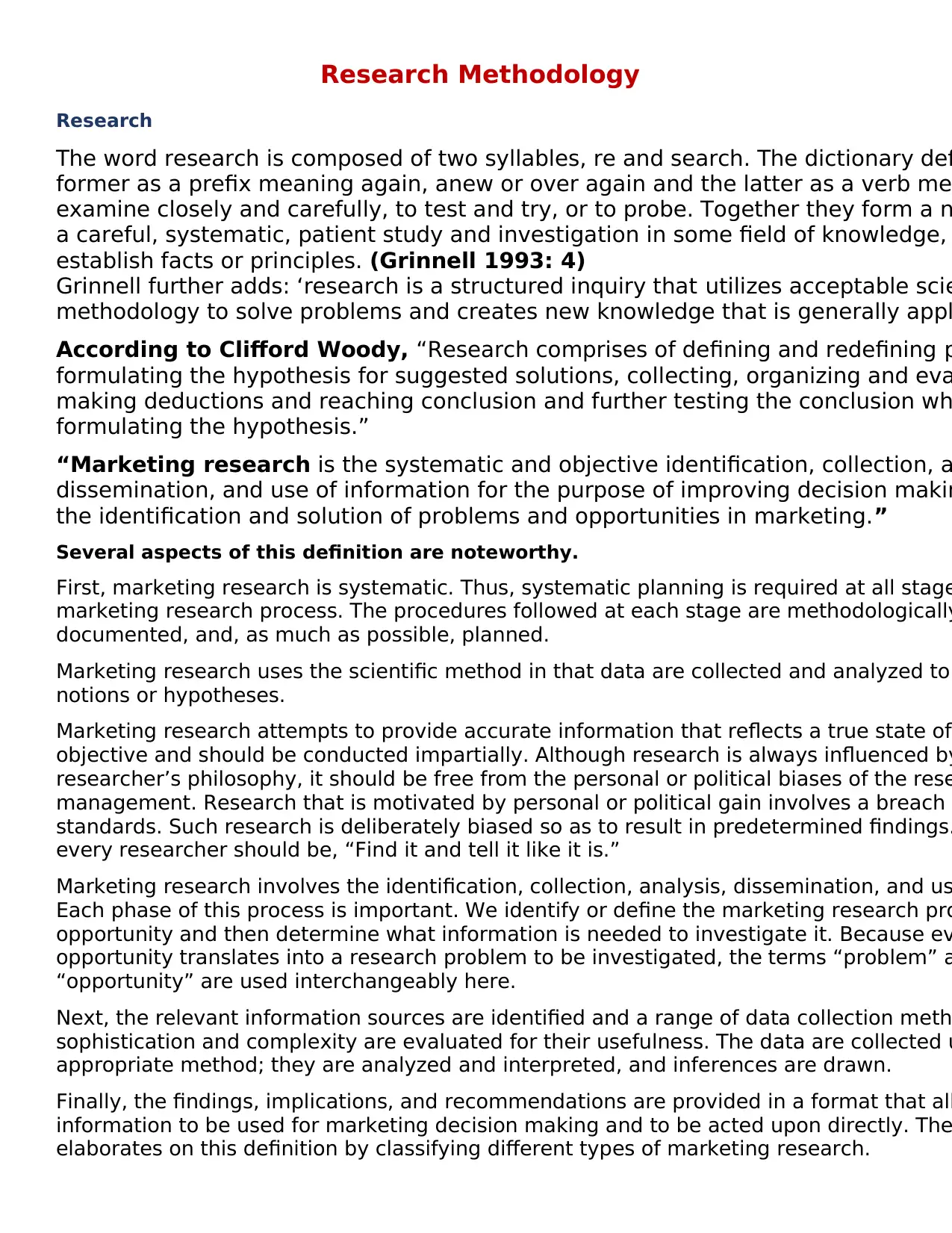
Research Methodology
Research
The word research is composed of two syllables, re and search. The dictionary defi
former as a prefix meaning again, anew or over again and the latter as a verb me
examine closely and carefully, to test and try, or to probe. Together they form a n
a careful, systematic, patient study and investigation in some field of knowledge,
establish facts or principles. (Grinnell 1993: 4)
Grinnell further adds: ‘research is a structured inquiry that utilizes acceptable scie
methodology to solve problems and creates new knowledge that is generally appl
According to Clifford Woody, “Research comprises of defining and redefining p
formulating the hypothesis for suggested solutions, collecting, organizing and eva
making deductions and reaching conclusion and further testing the conclusion wh
formulating the hypothesis.”
“Marketing research is the systematic and objective identification, collection, a
dissemination, and use of information for the purpose of improving decision makin
the identification and solution of problems and opportunities in marketing.”
Several aspects of this definition are noteworthy.
First, marketing research is systematic. Thus, systematic planning is required at all stage
marketing research process. The procedures followed at each stage are methodologically
documented, and, as much as possible, planned.
Marketing research uses the scientific method in that data are collected and analyzed to
notions or hypotheses.
Marketing research attempts to provide accurate information that reflects a true state of
objective and should be conducted impartially. Although research is always influenced by
researcher’s philosophy, it should be free from the personal or political biases of the rese
management. Research that is motivated by personal or political gain involves a breach o
standards. Such research is deliberately biased so as to result in predetermined findings.
every researcher should be, “Find it and tell it like it is.”
Marketing research involves the identification, collection, analysis, dissemination, and us
Each phase of this process is important. We identify or define the marketing research pro
opportunity and then determine what information is needed to investigate it. Because ev
opportunity translates into a research problem to be investigated, the terms “problem” a
“opportunity” are used interchangeably here.
Next, the relevant information sources are identified and a range of data collection meth
sophistication and complexity are evaluated for their usefulness. The data are collected u
appropriate method; they are analyzed and interpreted, and inferences are drawn.
Finally, the findings, implications, and recommendations are provided in a format that all
information to be used for marketing decision making and to be acted upon directly. The
elaborates on this definition by classifying different types of marketing research.
Research
The word research is composed of two syllables, re and search. The dictionary defi
former as a prefix meaning again, anew or over again and the latter as a verb me
examine closely and carefully, to test and try, or to probe. Together they form a n
a careful, systematic, patient study and investigation in some field of knowledge,
establish facts or principles. (Grinnell 1993: 4)
Grinnell further adds: ‘research is a structured inquiry that utilizes acceptable scie
methodology to solve problems and creates new knowledge that is generally appl
According to Clifford Woody, “Research comprises of defining and redefining p
formulating the hypothesis for suggested solutions, collecting, organizing and eva
making deductions and reaching conclusion and further testing the conclusion wh
formulating the hypothesis.”
“Marketing research is the systematic and objective identification, collection, a
dissemination, and use of information for the purpose of improving decision makin
the identification and solution of problems and opportunities in marketing.”
Several aspects of this definition are noteworthy.
First, marketing research is systematic. Thus, systematic planning is required at all stage
marketing research process. The procedures followed at each stage are methodologically
documented, and, as much as possible, planned.
Marketing research uses the scientific method in that data are collected and analyzed to
notions or hypotheses.
Marketing research attempts to provide accurate information that reflects a true state of
objective and should be conducted impartially. Although research is always influenced by
researcher’s philosophy, it should be free from the personal or political biases of the rese
management. Research that is motivated by personal or political gain involves a breach o
standards. Such research is deliberately biased so as to result in predetermined findings.
every researcher should be, “Find it and tell it like it is.”
Marketing research involves the identification, collection, analysis, dissemination, and us
Each phase of this process is important. We identify or define the marketing research pro
opportunity and then determine what information is needed to investigate it. Because ev
opportunity translates into a research problem to be investigated, the terms “problem” a
“opportunity” are used interchangeably here.
Next, the relevant information sources are identified and a range of data collection meth
sophistication and complexity are evaluated for their usefulness. The data are collected u
appropriate method; they are analyzed and interpreted, and inferences are drawn.
Finally, the findings, implications, and recommendations are provided in a format that all
information to be used for marketing decision making and to be acted upon directly. The
elaborates on this definition by classifying different types of marketing research.
Paraphrase This Document
Need a fresh take? Get an instant paraphrase of this document with our AI Paraphraser
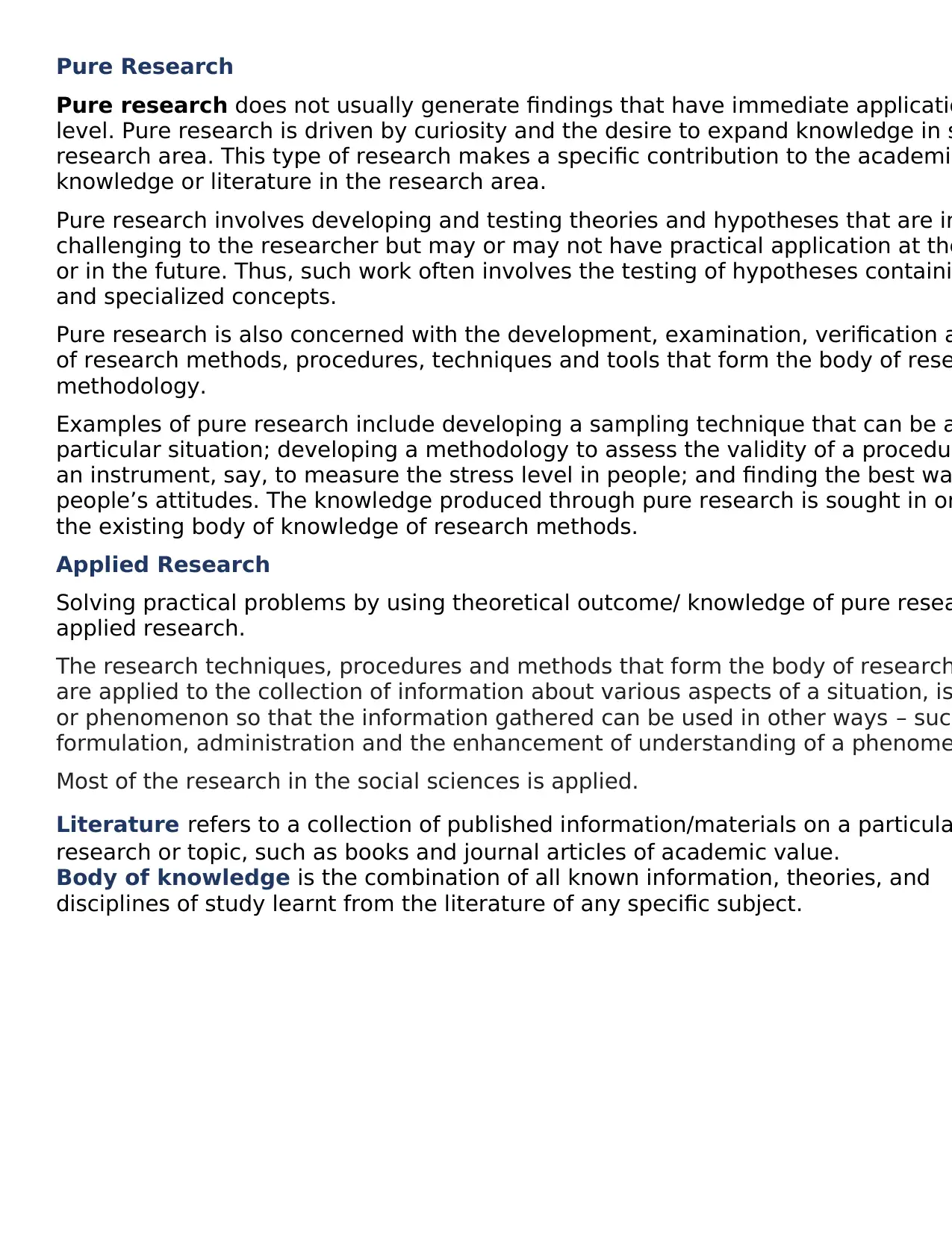
Pure Research
Pure research does not usually generate findings that have immediate applicatio
level. Pure research is driven by curiosity and the desire to expand knowledge in s
research area. This type of research makes a specific contribution to the academic
knowledge or literature in the research area.
Pure research involves developing and testing theories and hypotheses that are in
challenging to the researcher but may or may not have practical application at the
or in the future. Thus, such work often involves the testing of hypotheses containi
and specialized concepts.
Pure research is also concerned with the development, examination, verification a
of research methods, procedures, techniques and tools that form the body of rese
methodology.
Examples of pure research include developing a sampling technique that can be a
particular situation; developing a methodology to assess the validity of a procedur
an instrument, say, to measure the stress level in people; and finding the best wa
people’s attitudes. The knowledge produced through pure research is sought in or
the existing body of knowledge of research methods.
Applied Research
Solving practical problems by using theoretical outcome/ knowledge of pure resea
applied research.
The research techniques, procedures and methods that form the body of research
are applied to the collection of information about various aspects of a situation, is
or phenomenon so that the information gathered can be used in other ways – such
formulation, administration and the enhancement of understanding of a phenome
Most of the research in the social sciences is applied.
Literature refers to a collection of published information/materials on a particula
research or topic, such as books and journal articles of academic value.
Body of knowledge is the combination of all known information, theories, and
disciplines of study learnt from the literature of any specific subject.
Pure research does not usually generate findings that have immediate applicatio
level. Pure research is driven by curiosity and the desire to expand knowledge in s
research area. This type of research makes a specific contribution to the academic
knowledge or literature in the research area.
Pure research involves developing and testing theories and hypotheses that are in
challenging to the researcher but may or may not have practical application at the
or in the future. Thus, such work often involves the testing of hypotheses containi
and specialized concepts.
Pure research is also concerned with the development, examination, verification a
of research methods, procedures, techniques and tools that form the body of rese
methodology.
Examples of pure research include developing a sampling technique that can be a
particular situation; developing a methodology to assess the validity of a procedur
an instrument, say, to measure the stress level in people; and finding the best wa
people’s attitudes. The knowledge produced through pure research is sought in or
the existing body of knowledge of research methods.
Applied Research
Solving practical problems by using theoretical outcome/ knowledge of pure resea
applied research.
The research techniques, procedures and methods that form the body of research
are applied to the collection of information about various aspects of a situation, is
or phenomenon so that the information gathered can be used in other ways – such
formulation, administration and the enhancement of understanding of a phenome
Most of the research in the social sciences is applied.
Literature refers to a collection of published information/materials on a particula
research or topic, such as books and journal articles of academic value.
Body of knowledge is the combination of all known information, theories, and
disciplines of study learnt from the literature of any specific subject.
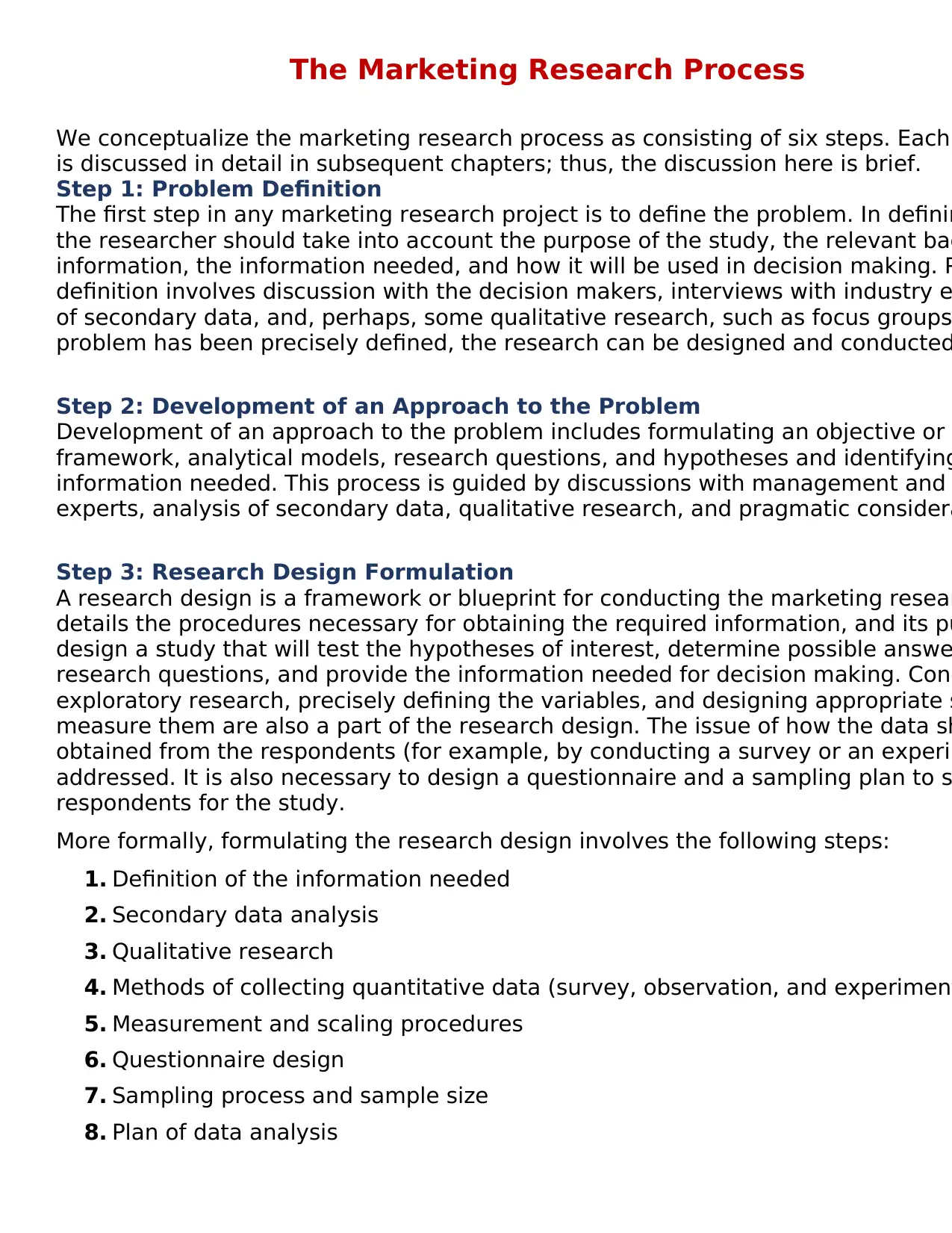
The Marketing Research Process
We conceptualize the marketing research process as consisting of six steps. Each
is discussed in detail in subsequent chapters; thus, the discussion here is brief.
Step 1: Problem Definition
The first step in any marketing research project is to define the problem. In definin
the researcher should take into account the purpose of the study, the relevant bac
information, the information needed, and how it will be used in decision making. P
definition involves discussion with the decision makers, interviews with industry e
of secondary data, and, perhaps, some qualitative research, such as focus groups
problem has been precisely defined, the research can be designed and conducted
Step 2: Development of an Approach to the Problem
Development of an approach to the problem includes formulating an objective or t
framework, analytical models, research questions, and hypotheses and identifying
information needed. This process is guided by discussions with management and
experts, analysis of secondary data, qualitative research, and pragmatic considera
Step 3: Research Design Formulation
A research design is a framework or blueprint for conducting the marketing resear
details the procedures necessary for obtaining the required information, and its pu
design a study that will test the hypotheses of interest, determine possible answe
research questions, and provide the information needed for decision making. Cond
exploratory research, precisely defining the variables, and designing appropriate s
measure them are also a part of the research design. The issue of how the data sh
obtained from the respondents (for example, by conducting a survey or an experim
addressed. It is also necessary to design a questionnaire and a sampling plan to s
respondents for the study.
More formally, formulating the research design involves the following steps:
1. Definition of the information needed
2. Secondary data analysis
3. Qualitative research
4. Methods of collecting quantitative data (survey, observation, and experiment
5. Measurement and scaling procedures
6. Questionnaire design
7. Sampling process and sample size
8. Plan of data analysis
We conceptualize the marketing research process as consisting of six steps. Each
is discussed in detail in subsequent chapters; thus, the discussion here is brief.
Step 1: Problem Definition
The first step in any marketing research project is to define the problem. In definin
the researcher should take into account the purpose of the study, the relevant bac
information, the information needed, and how it will be used in decision making. P
definition involves discussion with the decision makers, interviews with industry e
of secondary data, and, perhaps, some qualitative research, such as focus groups
problem has been precisely defined, the research can be designed and conducted
Step 2: Development of an Approach to the Problem
Development of an approach to the problem includes formulating an objective or t
framework, analytical models, research questions, and hypotheses and identifying
information needed. This process is guided by discussions with management and
experts, analysis of secondary data, qualitative research, and pragmatic considera
Step 3: Research Design Formulation
A research design is a framework or blueprint for conducting the marketing resear
details the procedures necessary for obtaining the required information, and its pu
design a study that will test the hypotheses of interest, determine possible answe
research questions, and provide the information needed for decision making. Cond
exploratory research, precisely defining the variables, and designing appropriate s
measure them are also a part of the research design. The issue of how the data sh
obtained from the respondents (for example, by conducting a survey or an experim
addressed. It is also necessary to design a questionnaire and a sampling plan to s
respondents for the study.
More formally, formulating the research design involves the following steps:
1. Definition of the information needed
2. Secondary data analysis
3. Qualitative research
4. Methods of collecting quantitative data (survey, observation, and experiment
5. Measurement and scaling procedures
6. Questionnaire design
7. Sampling process and sample size
8. Plan of data analysis
⊘ This is a preview!⊘
Do you want full access?
Subscribe today to unlock all pages.

Trusted by 1+ million students worldwide
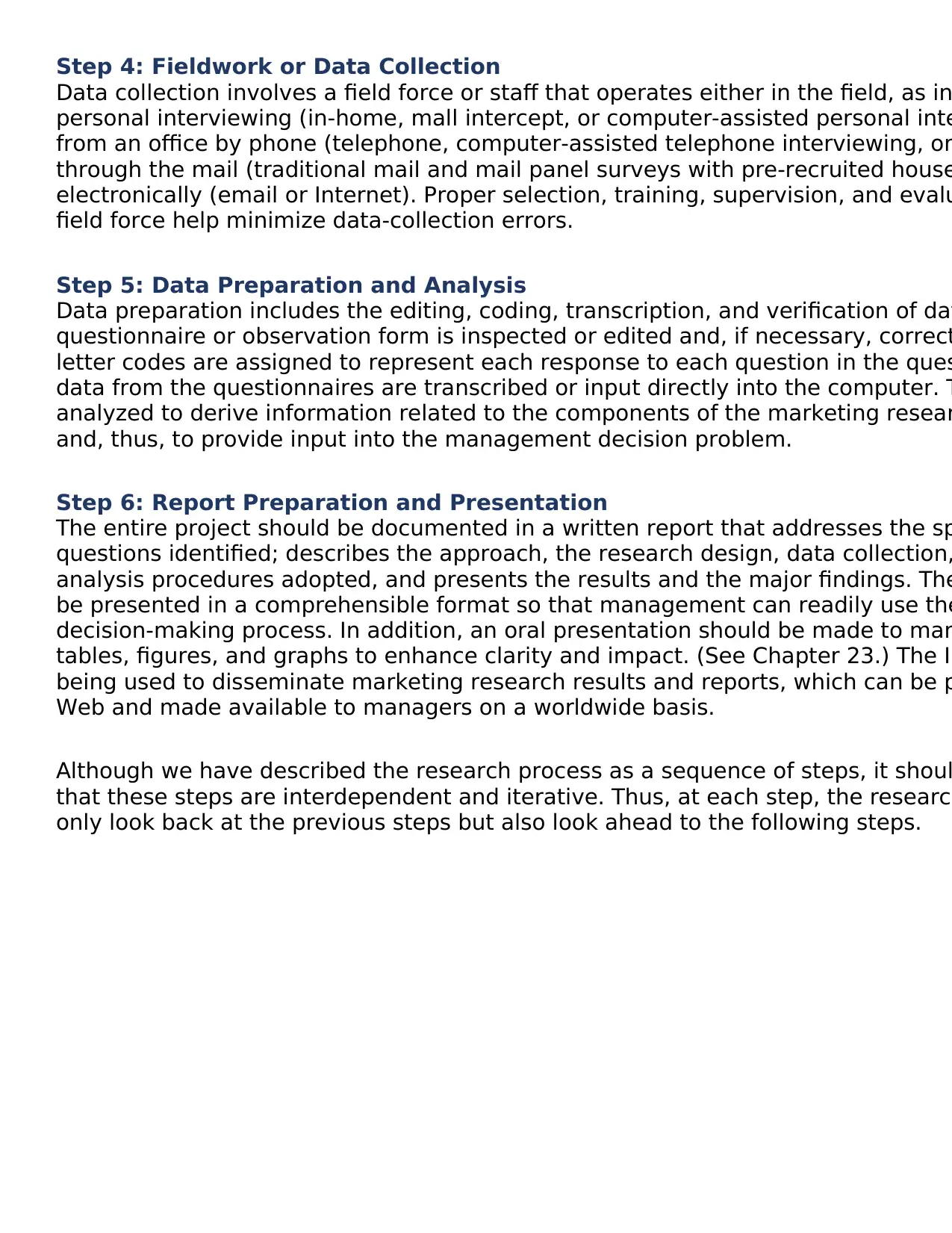
Step 4: Fieldwork or Data Collection
Data collection involves a field force or staff that operates either in the field, as in
personal interviewing (in-home, mall intercept, or computer-assisted personal inte
from an office by phone (telephone, computer-assisted telephone interviewing, or
through the mail (traditional mail and mail panel surveys with pre-recruited house
electronically (email or Internet). Proper selection, training, supervision, and evalu
field force help minimize data-collection errors.
Step 5: Data Preparation and Analysis
Data preparation includes the editing, coding, transcription, and verification of dat
questionnaire or observation form is inspected or edited and, if necessary, correct
letter codes are assigned to represent each response to each question in the ques
data from the questionnaires are transcribed or input directly into the computer. T
analyzed to derive information related to the components of the marketing resear
and, thus, to provide input into the management decision problem.
Step 6: Report Preparation and Presentation
The entire project should be documented in a written report that addresses the sp
questions identified; describes the approach, the research design, data collection,
analysis procedures adopted, and presents the results and the major findings. The
be presented in a comprehensible format so that management can readily use the
decision-making process. In addition, an oral presentation should be made to man
tables, figures, and graphs to enhance clarity and impact. (See Chapter 23.) The In
being used to disseminate marketing research results and reports, which can be p
Web and made available to managers on a worldwide basis.
Although we have described the research process as a sequence of steps, it shoul
that these steps are interdependent and iterative. Thus, at each step, the research
only look back at the previous steps but also look ahead to the following steps.
Data collection involves a field force or staff that operates either in the field, as in
personal interviewing (in-home, mall intercept, or computer-assisted personal inte
from an office by phone (telephone, computer-assisted telephone interviewing, or
through the mail (traditional mail and mail panel surveys with pre-recruited house
electronically (email or Internet). Proper selection, training, supervision, and evalu
field force help minimize data-collection errors.
Step 5: Data Preparation and Analysis
Data preparation includes the editing, coding, transcription, and verification of dat
questionnaire or observation form is inspected or edited and, if necessary, correct
letter codes are assigned to represent each response to each question in the ques
data from the questionnaires are transcribed or input directly into the computer. T
analyzed to derive information related to the components of the marketing resear
and, thus, to provide input into the management decision problem.
Step 6: Report Preparation and Presentation
The entire project should be documented in a written report that addresses the sp
questions identified; describes the approach, the research design, data collection,
analysis procedures adopted, and presents the results and the major findings. The
be presented in a comprehensible format so that management can readily use the
decision-making process. In addition, an oral presentation should be made to man
tables, figures, and graphs to enhance clarity and impact. (See Chapter 23.) The In
being used to disseminate marketing research results and reports, which can be p
Web and made available to managers on a worldwide basis.
Although we have described the research process as a sequence of steps, it shoul
that these steps are interdependent and iterative. Thus, at each step, the research
only look back at the previous steps but also look ahead to the following steps.
Paraphrase This Document
Need a fresh take? Get an instant paraphrase of this document with our AI Paraphraser
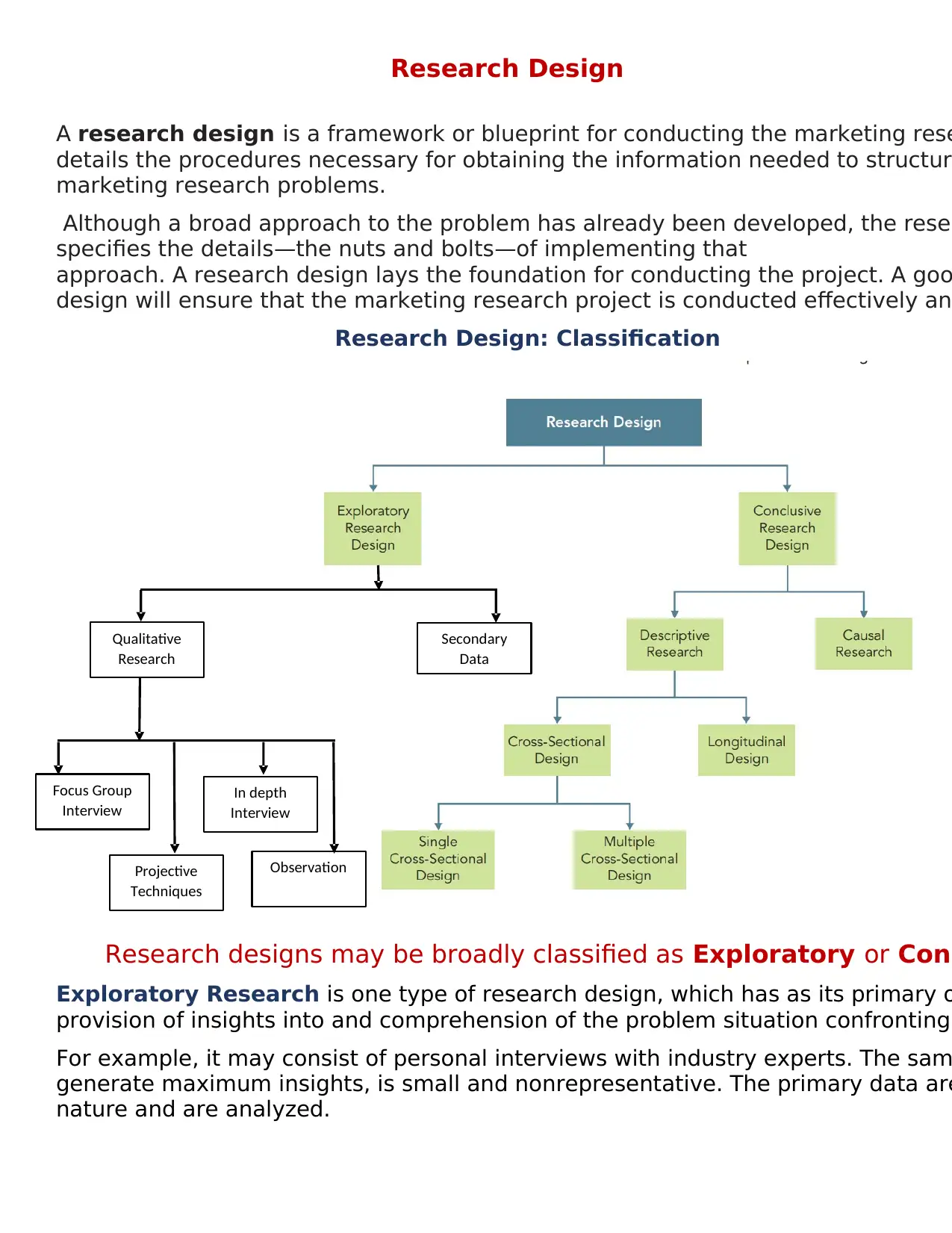
Research Design
A research design is a framework or blueprint for conducting the marketing rese
details the procedures necessary for obtaining the information needed to structure
marketing research problems.
Although a broad approach to the problem has already been developed, the resea
specifies the details—the nuts and bolts—of implementing that
approach. A research design lays the foundation for conducting the project. A goo
design will ensure that the marketing research project is conducted effectively an
Research Design: Classification
Research designs may be broadly classified as Exploratory or Conc
Exploratory Research is one type of research design, which has as its primary o
provision of insights into and comprehension of the problem situation confronting
For example, it may consist of personal interviews with industry experts. The sam
generate maximum insights, is small and nonrepresentative. The primary data are
nature and are analyzed.
Secondary
Data
Qualitative
Research
Focus Group
Interview
Projective
Techniques
In depth
Interview
Observation
A research design is a framework or blueprint for conducting the marketing rese
details the procedures necessary for obtaining the information needed to structure
marketing research problems.
Although a broad approach to the problem has already been developed, the resea
specifies the details—the nuts and bolts—of implementing that
approach. A research design lays the foundation for conducting the project. A goo
design will ensure that the marketing research project is conducted effectively an
Research Design: Classification
Research designs may be broadly classified as Exploratory or Conc
Exploratory Research is one type of research design, which has as its primary o
provision of insights into and comprehension of the problem situation confronting
For example, it may consist of personal interviews with industry experts. The sam
generate maximum insights, is small and nonrepresentative. The primary data are
nature and are analyzed.
Secondary
Data
Qualitative
Research
Focus Group
Interview
Projective
Techniques
In depth
Interview
Observation
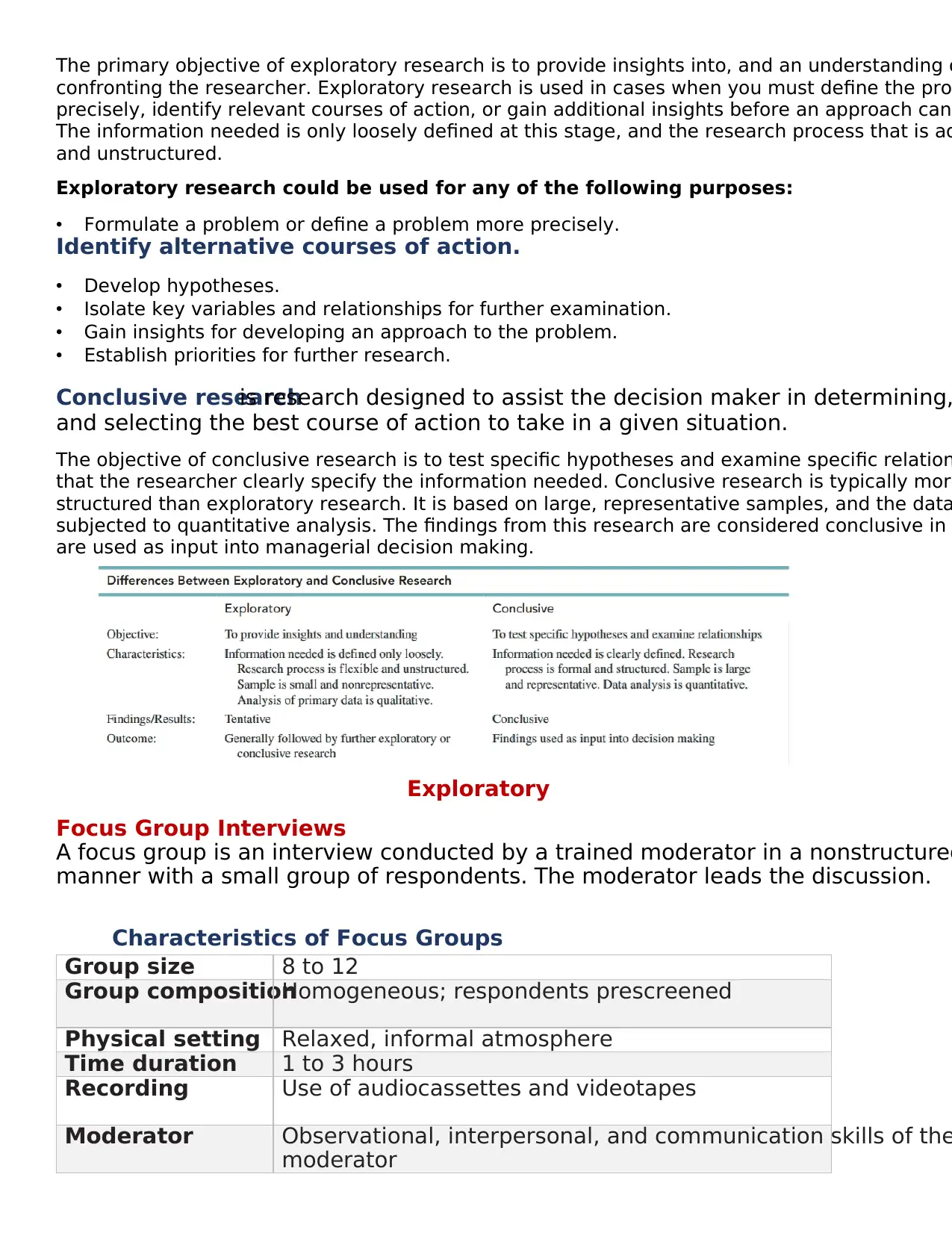
The primary objective of exploratory research is to provide insights into, and an understanding o
confronting the researcher. Exploratory research is used in cases when you must define the pro
precisely, identify relevant courses of action, or gain additional insights before an approach can
The information needed is only loosely defined at this stage, and the research process that is ad
and unstructured.
Exploratory research could be used for any of the following purposes:
• Formulate a problem or define a problem more precisely.
Identify alternative courses of action.
• Develop hypotheses.
• Isolate key variables and relationships for further examination.
• Gain insights for developing an approach to the problem.
• Establish priorities for further research.
Conclusive researchis research designed to assist the decision maker in determining,
and selecting the best course of action to take in a given situation.
The objective of conclusive research is to test specific hypotheses and examine specific relation
that the researcher clearly specify the information needed. Conclusive research is typically more
structured than exploratory research. It is based on large, representative samples, and the data
subjected to quantitative analysis. The findings from this research are considered conclusive in
are used as input into managerial decision making.
Exploratory
Focus Group Interviews
A focus group is an interview conducted by a trained moderator in a nonstructured
manner with a small group of respondents. The moderator leads the discussion.
Characteristics of Focus Groups
Group size 8 to 12
Group compositionHomogeneous; respondents prescreened
Physical setting Relaxed, informal atmosphere
Time duration 1 to 3 hours
Recording Use of audiocassettes and videotapes
Moderator Observational, interpersonal, and communication skills of the
moderator
confronting the researcher. Exploratory research is used in cases when you must define the pro
precisely, identify relevant courses of action, or gain additional insights before an approach can
The information needed is only loosely defined at this stage, and the research process that is ad
and unstructured.
Exploratory research could be used for any of the following purposes:
• Formulate a problem or define a problem more precisely.
Identify alternative courses of action.
• Develop hypotheses.
• Isolate key variables and relationships for further examination.
• Gain insights for developing an approach to the problem.
• Establish priorities for further research.
Conclusive researchis research designed to assist the decision maker in determining,
and selecting the best course of action to take in a given situation.
The objective of conclusive research is to test specific hypotheses and examine specific relation
that the researcher clearly specify the information needed. Conclusive research is typically more
structured than exploratory research. It is based on large, representative samples, and the data
subjected to quantitative analysis. The findings from this research are considered conclusive in
are used as input into managerial decision making.
Exploratory
Focus Group Interviews
A focus group is an interview conducted by a trained moderator in a nonstructured
manner with a small group of respondents. The moderator leads the discussion.
Characteristics of Focus Groups
Group size 8 to 12
Group compositionHomogeneous; respondents prescreened
Physical setting Relaxed, informal atmosphere
Time duration 1 to 3 hours
Recording Use of audiocassettes and videotapes
Moderator Observational, interpersonal, and communication skills of the
moderator
⊘ This is a preview!⊘
Do you want full access?
Subscribe today to unlock all pages.

Trusted by 1+ million students worldwide
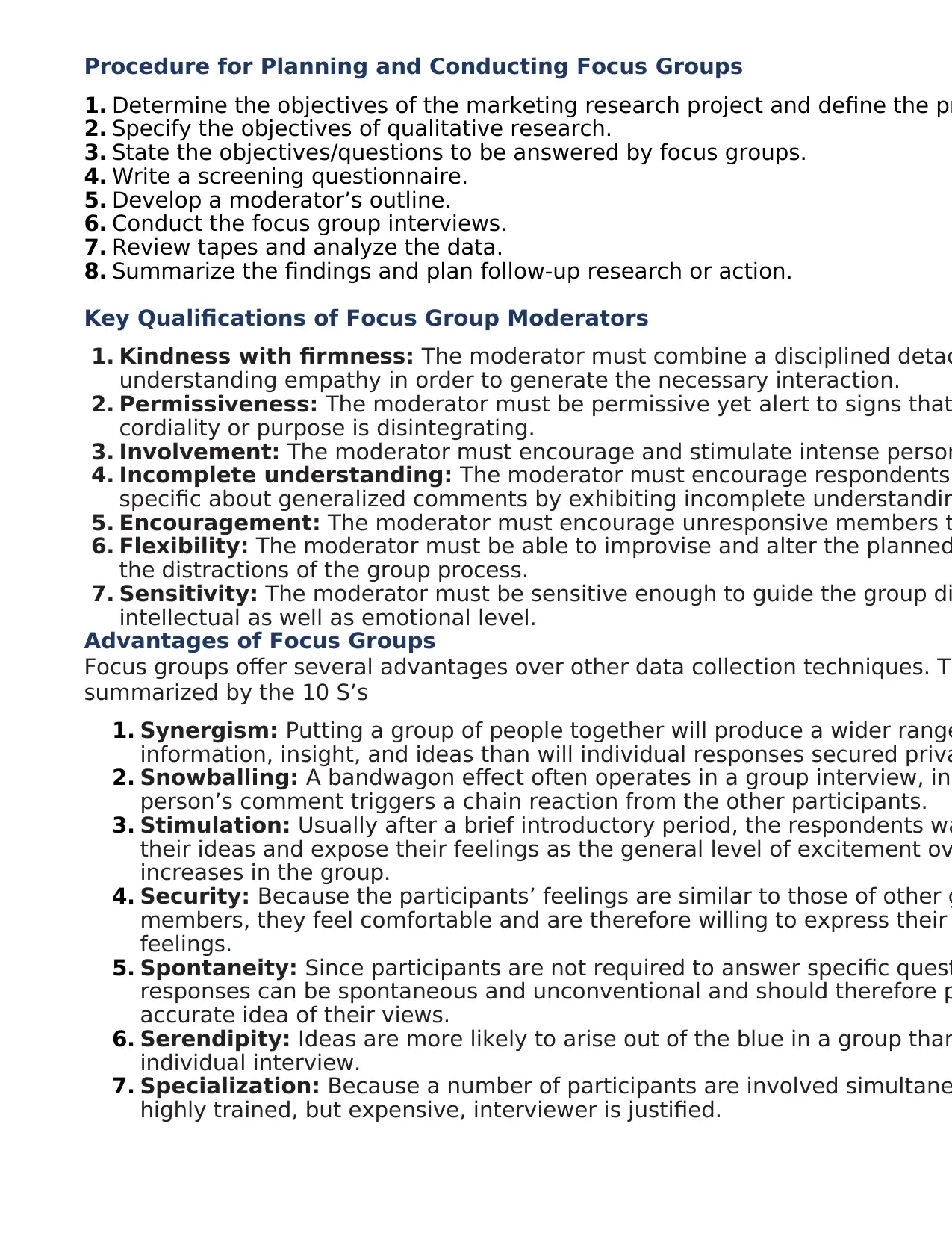
Procedure for Planning and Conducting Focus Groups
1. Determine the objectives of the marketing research project and define the pr
2. Specify the objectives of qualitative research.
3. State the objectives/questions to be answered by focus groups.
4. Write a screening questionnaire.
5. Develop a moderator’s outline.
6. Conduct the focus group interviews.
7. Review tapes and analyze the data.
8. Summarize the findings and plan follow-up research or action.
Key Qualifications of Focus Group Moderators
1. Kindness with firmness: The moderator must combine a disciplined detac
understanding empathy in order to generate the necessary interaction.
2. Permissiveness: The moderator must be permissive yet alert to signs that
cordiality or purpose is disintegrating.
3. Involvement: The moderator must encourage and stimulate intense person
4. Incomplete understanding: The moderator must encourage respondents
specific about generalized comments by exhibiting incomplete understandin
5. Encouragement: The moderator must encourage unresponsive members t
6. Flexibility: The moderator must be able to improvise and alter the planned
the distractions of the group process.
7. Sensitivity: The moderator must be sensitive enough to guide the group di
intellectual as well as emotional level.
Advantages of Focus Groups
Focus groups offer several advantages over other data collection techniques. Th
summarized by the 10 S’s
1. Synergism: Putting a group of people together will produce a wider range
information, insight, and ideas than will individual responses secured priva
2. Snowballing: A bandwagon effect often operates in a group interview, in
person’s comment triggers a chain reaction from the other participants.
3. Stimulation: Usually after a brief introductory period, the respondents wa
their ideas and expose their feelings as the general level of excitement ov
increases in the group.
4. Security: Because the participants’ feelings are similar to those of other g
members, they feel comfortable and are therefore willing to express their
feelings.
5. Spontaneity: Since participants are not required to answer specific quest
responses can be spontaneous and unconventional and should therefore p
accurate idea of their views.
6. Serendipity: Ideas are more likely to arise out of the blue in a group than
individual interview.
7. Specialization: Because a number of participants are involved simultane
highly trained, but expensive, interviewer is justified.
1. Determine the objectives of the marketing research project and define the pr
2. Specify the objectives of qualitative research.
3. State the objectives/questions to be answered by focus groups.
4. Write a screening questionnaire.
5. Develop a moderator’s outline.
6. Conduct the focus group interviews.
7. Review tapes and analyze the data.
8. Summarize the findings and plan follow-up research or action.
Key Qualifications of Focus Group Moderators
1. Kindness with firmness: The moderator must combine a disciplined detac
understanding empathy in order to generate the necessary interaction.
2. Permissiveness: The moderator must be permissive yet alert to signs that
cordiality or purpose is disintegrating.
3. Involvement: The moderator must encourage and stimulate intense person
4. Incomplete understanding: The moderator must encourage respondents
specific about generalized comments by exhibiting incomplete understandin
5. Encouragement: The moderator must encourage unresponsive members t
6. Flexibility: The moderator must be able to improvise and alter the planned
the distractions of the group process.
7. Sensitivity: The moderator must be sensitive enough to guide the group di
intellectual as well as emotional level.
Advantages of Focus Groups
Focus groups offer several advantages over other data collection techniques. Th
summarized by the 10 S’s
1. Synergism: Putting a group of people together will produce a wider range
information, insight, and ideas than will individual responses secured priva
2. Snowballing: A bandwagon effect often operates in a group interview, in
person’s comment triggers a chain reaction from the other participants.
3. Stimulation: Usually after a brief introductory period, the respondents wa
their ideas and expose their feelings as the general level of excitement ov
increases in the group.
4. Security: Because the participants’ feelings are similar to those of other g
members, they feel comfortable and are therefore willing to express their
feelings.
5. Spontaneity: Since participants are not required to answer specific quest
responses can be spontaneous and unconventional and should therefore p
accurate idea of their views.
6. Serendipity: Ideas are more likely to arise out of the blue in a group than
individual interview.
7. Specialization: Because a number of participants are involved simultane
highly trained, but expensive, interviewer is justified.
Paraphrase This Document
Need a fresh take? Get an instant paraphrase of this document with our AI Paraphraser
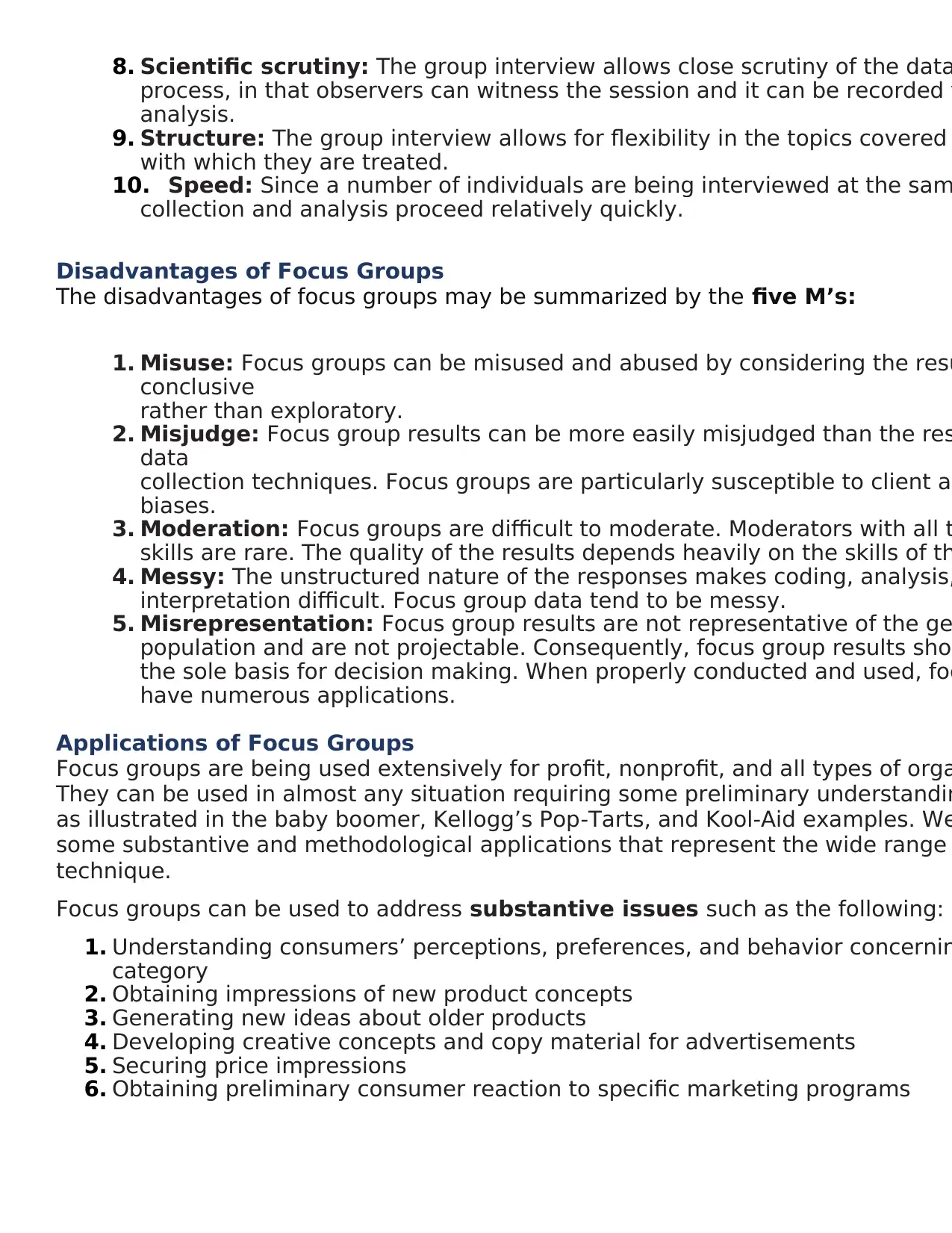
8. Scientific scrutiny: The group interview allows close scrutiny of the data
process, in that observers can witness the session and it can be recorded f
analysis.
9. Structure: The group interview allows for flexibility in the topics covered
with which they are treated.
10. Speed: Since a number of individuals are being interviewed at the sam
collection and analysis proceed relatively quickly.
Disadvantages of Focus Groups
The disadvantages of focus groups may be summarized by the five M’s:
1. Misuse: Focus groups can be misused and abused by considering the resu
conclusive
rather than exploratory.
2. Misjudge: Focus group results can be more easily misjudged than the res
data
collection techniques. Focus groups are particularly susceptible to client an
biases.
3. Moderation: Focus groups are difficult to moderate. Moderators with all t
skills are rare. The quality of the results depends heavily on the skills of th
4. Messy: The unstructured nature of the responses makes coding, analysis,
interpretation difficult. Focus group data tend to be messy.
5. Misrepresentation: Focus group results are not representative of the ge
population and are not projectable. Consequently, focus group results shou
the sole basis for decision making. When properly conducted and used, foc
have numerous applications.
Applications of Focus Groups
Focus groups are being used extensively for profit, nonprofit, and all types of orga
They can be used in almost any situation requiring some preliminary understandin
as illustrated in the baby boomer, Kellogg’s Pop-Tarts, and Kool-Aid examples. We
some substantive and methodological applications that represent the wide range
technique.
Focus groups can be used to address substantive issues such as the following:
1. Understanding consumers’ perceptions, preferences, and behavior concernin
category
2. Obtaining impressions of new product concepts
3. Generating new ideas about older products
4. Developing creative concepts and copy material for advertisements
5. Securing price impressions
6. Obtaining preliminary consumer reaction to specific marketing programs
process, in that observers can witness the session and it can be recorded f
analysis.
9. Structure: The group interview allows for flexibility in the topics covered
with which they are treated.
10. Speed: Since a number of individuals are being interviewed at the sam
collection and analysis proceed relatively quickly.
Disadvantages of Focus Groups
The disadvantages of focus groups may be summarized by the five M’s:
1. Misuse: Focus groups can be misused and abused by considering the resu
conclusive
rather than exploratory.
2. Misjudge: Focus group results can be more easily misjudged than the res
data
collection techniques. Focus groups are particularly susceptible to client an
biases.
3. Moderation: Focus groups are difficult to moderate. Moderators with all t
skills are rare. The quality of the results depends heavily on the skills of th
4. Messy: The unstructured nature of the responses makes coding, analysis,
interpretation difficult. Focus group data tend to be messy.
5. Misrepresentation: Focus group results are not representative of the ge
population and are not projectable. Consequently, focus group results shou
the sole basis for decision making. When properly conducted and used, foc
have numerous applications.
Applications of Focus Groups
Focus groups are being used extensively for profit, nonprofit, and all types of orga
They can be used in almost any situation requiring some preliminary understandin
as illustrated in the baby boomer, Kellogg’s Pop-Tarts, and Kool-Aid examples. We
some substantive and methodological applications that represent the wide range
technique.
Focus groups can be used to address substantive issues such as the following:
1. Understanding consumers’ perceptions, preferences, and behavior concernin
category
2. Obtaining impressions of new product concepts
3. Generating new ideas about older products
4. Developing creative concepts and copy material for advertisements
5. Securing price impressions
6. Obtaining preliminary consumer reaction to specific marketing programs
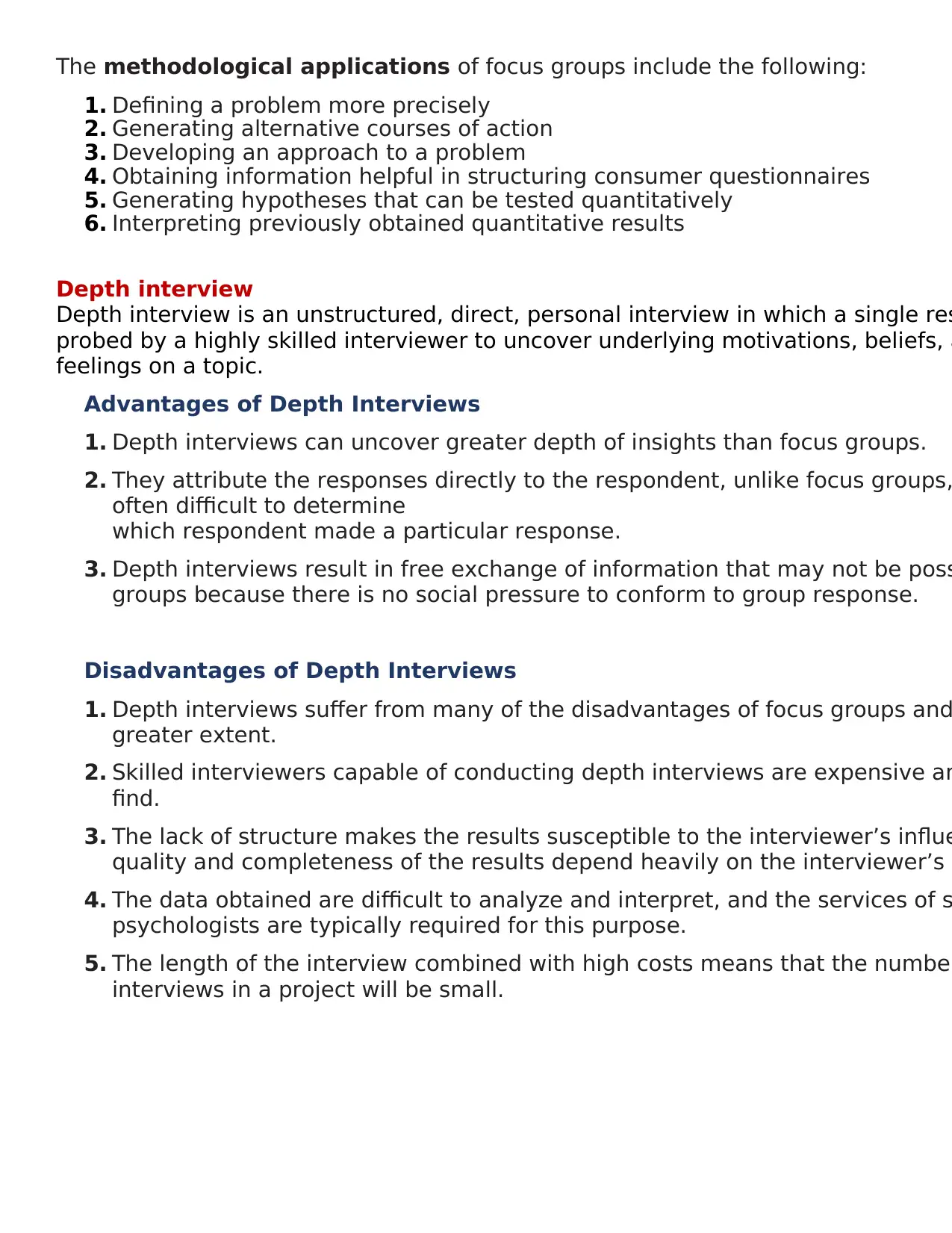
The methodological applications of focus groups include the following:
1. Defining a problem more precisely
2. Generating alternative courses of action
3. Developing an approach to a problem
4. Obtaining information helpful in structuring consumer questionnaires
5. Generating hypotheses that can be tested quantitatively
6. Interpreting previously obtained quantitative results
Depth interview
Depth interview is an unstructured, direct, personal interview in which a single res
probed by a highly skilled interviewer to uncover underlying motivations, beliefs, a
feelings on a topic.
Advantages of Depth Interviews
1. Depth interviews can uncover greater depth of insights than focus groups.
2. They attribute the responses directly to the respondent, unlike focus groups,
often difficult to determine
which respondent made a particular response.
3. Depth interviews result in free exchange of information that may not be poss
groups because there is no social pressure to conform to group response.
Disadvantages of Depth Interviews
1. Depth interviews suffer from many of the disadvantages of focus groups and
greater extent.
2. Skilled interviewers capable of conducting depth interviews are expensive an
find.
3. The lack of structure makes the results susceptible to the interviewer’s influe
quality and completeness of the results depend heavily on the interviewer’s s
4. The data obtained are difficult to analyze and interpret, and the services of s
psychologists are typically required for this purpose.
5. The length of the interview combined with high costs means that the number
interviews in a project will be small.
1. Defining a problem more precisely
2. Generating alternative courses of action
3. Developing an approach to a problem
4. Obtaining information helpful in structuring consumer questionnaires
5. Generating hypotheses that can be tested quantitatively
6. Interpreting previously obtained quantitative results
Depth interview
Depth interview is an unstructured, direct, personal interview in which a single res
probed by a highly skilled interviewer to uncover underlying motivations, beliefs, a
feelings on a topic.
Advantages of Depth Interviews
1. Depth interviews can uncover greater depth of insights than focus groups.
2. They attribute the responses directly to the respondent, unlike focus groups,
often difficult to determine
which respondent made a particular response.
3. Depth interviews result in free exchange of information that may not be poss
groups because there is no social pressure to conform to group response.
Disadvantages of Depth Interviews
1. Depth interviews suffer from many of the disadvantages of focus groups and
greater extent.
2. Skilled interviewers capable of conducting depth interviews are expensive an
find.
3. The lack of structure makes the results susceptible to the interviewer’s influe
quality and completeness of the results depend heavily on the interviewer’s s
4. The data obtained are difficult to analyze and interpret, and the services of s
psychologists are typically required for this purpose.
5. The length of the interview combined with high costs means that the number
interviews in a project will be small.
⊘ This is a preview!⊘
Do you want full access?
Subscribe today to unlock all pages.

Trusted by 1+ million students worldwide
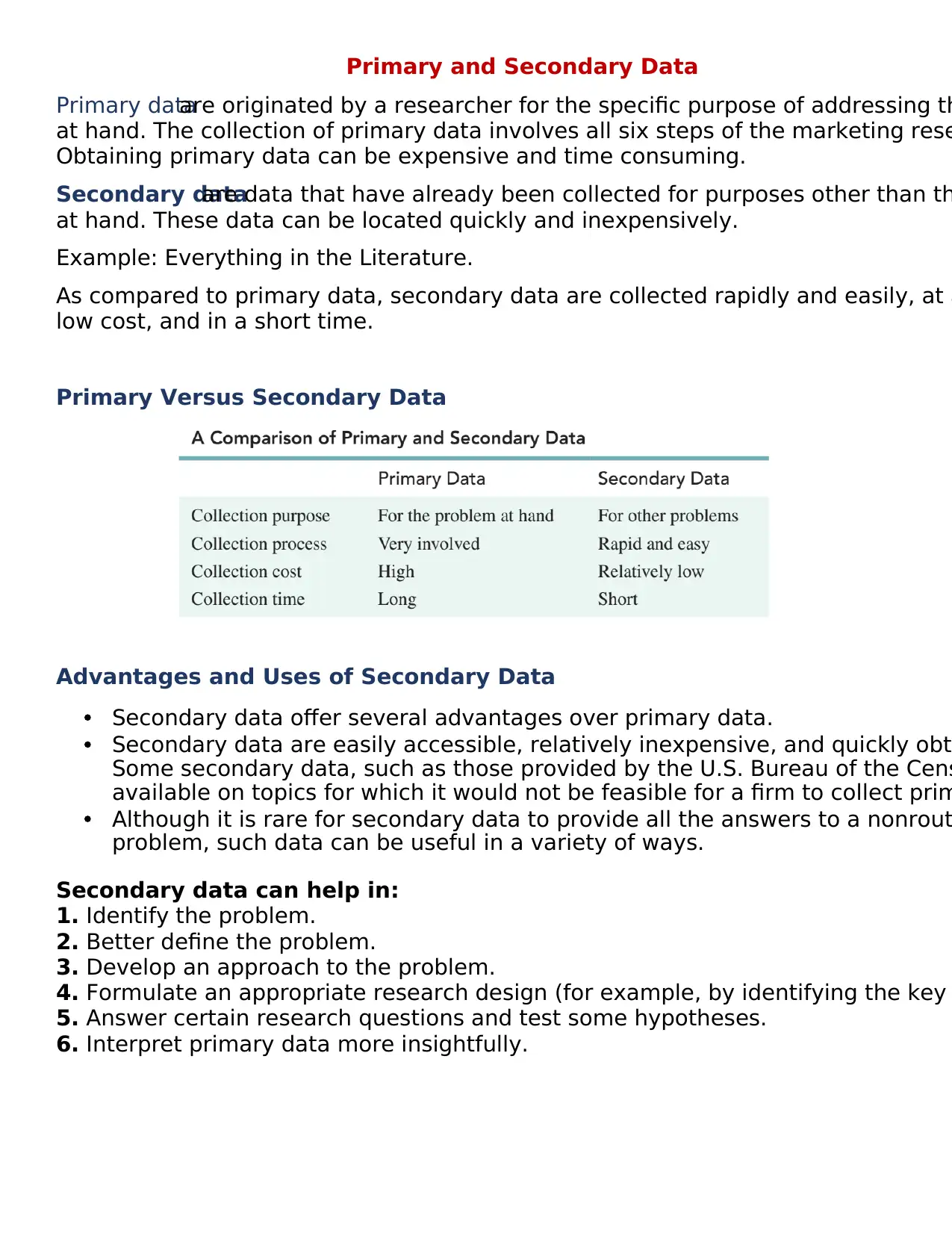
Primary and Secondary Data
Primary dataare originated by a researcher for the specific purpose of addressing th
at hand. The collection of primary data involves all six steps of the marketing rese
Obtaining primary data can be expensive and time consuming.
Secondary dataare data that have already been collected for purposes other than th
at hand. These data can be located quickly and inexpensively.
Example: Everything in the Literature.
As compared to primary data, secondary data are collected rapidly and easily, at a
low cost, and in a short time.
Primary Versus Secondary Data
Advantages and Uses of Secondary Data
• Secondary data offer several advantages over primary data.
• Secondary data are easily accessible, relatively inexpensive, and quickly obta
Some secondary data, such as those provided by the U.S. Bureau of the Cens
available on topics for which it would not be feasible for a firm to collect prim
• Although it is rare for secondary data to provide all the answers to a nonrout
problem, such data can be useful in a variety of ways.
Secondary data can help in:
1. Identify the problem.
2. Better define the problem.
3. Develop an approach to the problem.
4. Formulate an appropriate research design (for example, by identifying the key
5. Answer certain research questions and test some hypotheses.
6. Interpret primary data more insightfully.
Primary dataare originated by a researcher for the specific purpose of addressing th
at hand. The collection of primary data involves all six steps of the marketing rese
Obtaining primary data can be expensive and time consuming.
Secondary dataare data that have already been collected for purposes other than th
at hand. These data can be located quickly and inexpensively.
Example: Everything in the Literature.
As compared to primary data, secondary data are collected rapidly and easily, at a
low cost, and in a short time.
Primary Versus Secondary Data
Advantages and Uses of Secondary Data
• Secondary data offer several advantages over primary data.
• Secondary data are easily accessible, relatively inexpensive, and quickly obta
Some secondary data, such as those provided by the U.S. Bureau of the Cens
available on topics for which it would not be feasible for a firm to collect prim
• Although it is rare for secondary data to provide all the answers to a nonrout
problem, such data can be useful in a variety of ways.
Secondary data can help in:
1. Identify the problem.
2. Better define the problem.
3. Develop an approach to the problem.
4. Formulate an appropriate research design (for example, by identifying the key
5. Answer certain research questions and test some hypotheses.
6. Interpret primary data more insightfully.
Paraphrase This Document
Need a fresh take? Get an instant paraphrase of this document with our AI Paraphraser
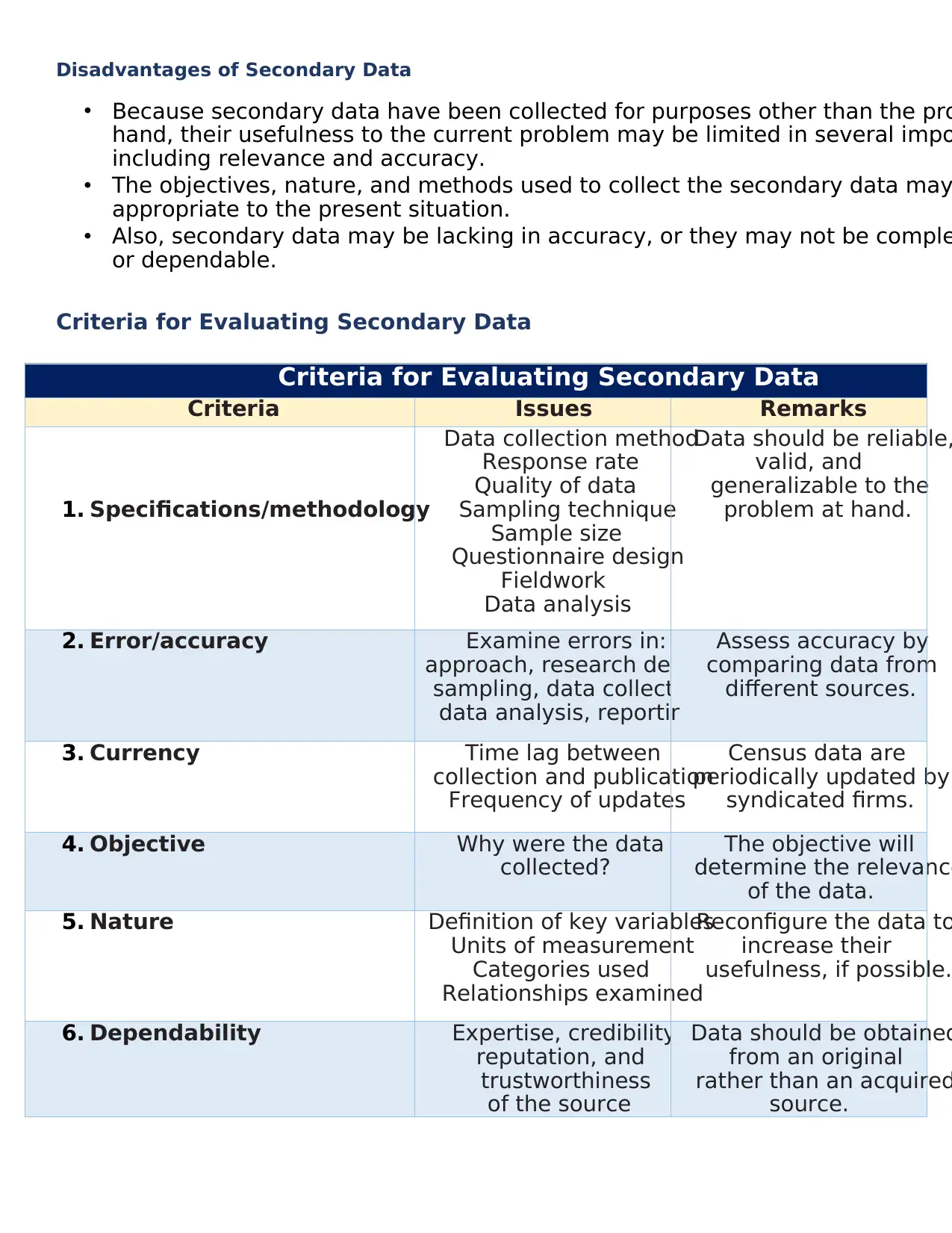
Disadvantages of Secondary Data
• Because secondary data have been collected for purposes other than the pro
hand, their usefulness to the current problem may be limited in several impo
including relevance and accuracy.
• The objectives, nature, and methods used to collect the secondary data may
appropriate to the present situation.
• Also, secondary data may be lacking in accuracy, or they may not be comple
or dependable.
Criteria for Evaluating Secondary Data
Criteria for Evaluating Secondary Data
Criteria Issues Remarks
1. Specifications/methodology
Data collection method
Response rate
Quality of data
Sampling technique
Sample size
Questionnaire design
Fieldwork
Data analysis
Data should be reliable,
valid, and
generalizable to the
problem at hand.
2. Error/accuracy Examine errors in:
approach, research design,
sampling, data collection,
data analysis, reporting
Assess accuracy by
comparing data from
different sources.
3. Currency Time lag between
collection and publication
Frequency of updates
Census data are
periodically updated by
syndicated firms.
4. Objective Why were the data
collected?
The objective will
determine the relevance
of the data.
5. Nature Definition of key variables
Units of measurement
Categories used
Relationships examined
Reconfigure the data to
increase their
usefulness, if possible.
6. Dependability Expertise, credibility,
reputation, and
trustworthiness
of the source
Data should be obtained
from an original
rather than an acquired
source.
• Because secondary data have been collected for purposes other than the pro
hand, their usefulness to the current problem may be limited in several impo
including relevance and accuracy.
• The objectives, nature, and methods used to collect the secondary data may
appropriate to the present situation.
• Also, secondary data may be lacking in accuracy, or they may not be comple
or dependable.
Criteria for Evaluating Secondary Data
Criteria for Evaluating Secondary Data
Criteria Issues Remarks
1. Specifications/methodology
Data collection method
Response rate
Quality of data
Sampling technique
Sample size
Questionnaire design
Fieldwork
Data analysis
Data should be reliable,
valid, and
generalizable to the
problem at hand.
2. Error/accuracy Examine errors in:
approach, research design,
sampling, data collection,
data analysis, reporting
Assess accuracy by
comparing data from
different sources.
3. Currency Time lag between
collection and publication
Frequency of updates
Census data are
periodically updated by
syndicated firms.
4. Objective Why were the data
collected?
The objective will
determine the relevance
of the data.
5. Nature Definition of key variables
Units of measurement
Categories used
Relationships examined
Reconfigure the data to
increase their
usefulness, if possible.
6. Dependability Expertise, credibility,
reputation, and
trustworthiness
of the source
Data should be obtained
from an original
rather than an acquired
source.
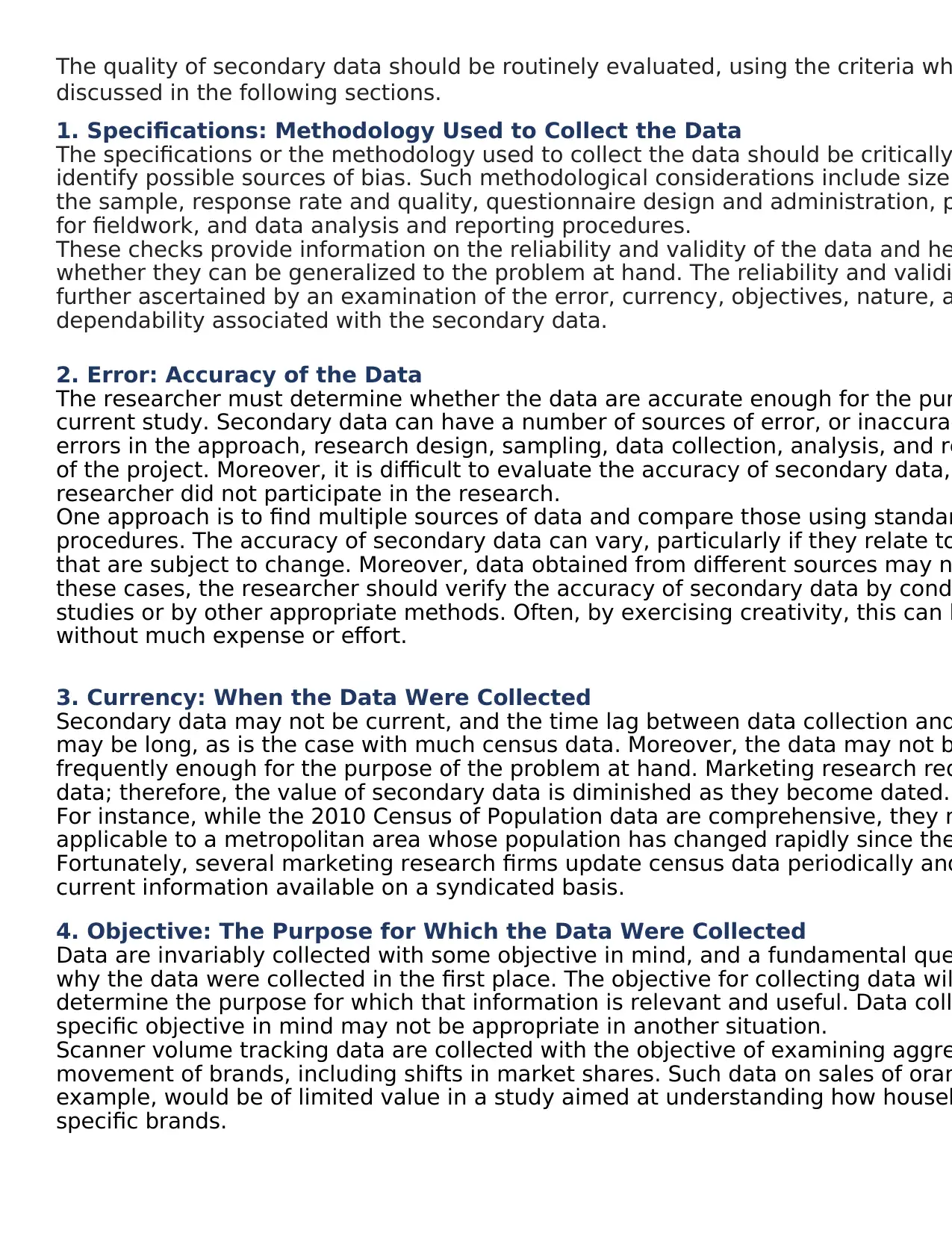
The quality of secondary data should be routinely evaluated, using the criteria wh
discussed in the following sections.
1. Specifications: Methodology Used to Collect the Data
The specifications or the methodology used to collect the data should be critically
identify possible sources of bias. Such methodological considerations include size
the sample, response rate and quality, questionnaire design and administration, p
for fieldwork, and data analysis and reporting procedures.
These checks provide information on the reliability and validity of the data and he
whether they can be generalized to the problem at hand. The reliability and validi
further ascertained by an examination of the error, currency, objectives, nature, a
dependability associated with the secondary data.
2. Error: Accuracy of the Data
The researcher must determine whether the data are accurate enough for the pur
current study. Secondary data can have a number of sources of error, or inaccurac
errors in the approach, research design, sampling, data collection, analysis, and re
of the project. Moreover, it is difficult to evaluate the accuracy of secondary data,
researcher did not participate in the research.
One approach is to find multiple sources of data and compare those using standar
procedures. The accuracy of secondary data can vary, particularly if they relate to
that are subject to change. Moreover, data obtained from different sources may n
these cases, the researcher should verify the accuracy of secondary data by cond
studies or by other appropriate methods. Often, by exercising creativity, this can b
without much expense or effort.
3. Currency: When the Data Were Collected
Secondary data may not be current, and the time lag between data collection and
may be long, as is the case with much census data. Moreover, the data may not b
frequently enough for the purpose of the problem at hand. Marketing research req
data; therefore, the value of secondary data is diminished as they become dated.
For instance, while the 2010 Census of Population data are comprehensive, they m
applicable to a metropolitan area whose population has changed rapidly since the
Fortunately, several marketing research firms update census data periodically and
current information available on a syndicated basis.
4. Objective: The Purpose for Which the Data Were Collected
Data are invariably collected with some objective in mind, and a fundamental que
why the data were collected in the first place. The objective for collecting data wil
determine the purpose for which that information is relevant and useful. Data coll
specific objective in mind may not be appropriate in another situation.
Scanner volume tracking data are collected with the objective of examining aggre
movement of brands, including shifts in market shares. Such data on sales of oran
example, would be of limited value in a study aimed at understanding how househ
specific brands.
discussed in the following sections.
1. Specifications: Methodology Used to Collect the Data
The specifications or the methodology used to collect the data should be critically
identify possible sources of bias. Such methodological considerations include size
the sample, response rate and quality, questionnaire design and administration, p
for fieldwork, and data analysis and reporting procedures.
These checks provide information on the reliability and validity of the data and he
whether they can be generalized to the problem at hand. The reliability and validi
further ascertained by an examination of the error, currency, objectives, nature, a
dependability associated with the secondary data.
2. Error: Accuracy of the Data
The researcher must determine whether the data are accurate enough for the pur
current study. Secondary data can have a number of sources of error, or inaccurac
errors in the approach, research design, sampling, data collection, analysis, and re
of the project. Moreover, it is difficult to evaluate the accuracy of secondary data,
researcher did not participate in the research.
One approach is to find multiple sources of data and compare those using standar
procedures. The accuracy of secondary data can vary, particularly if they relate to
that are subject to change. Moreover, data obtained from different sources may n
these cases, the researcher should verify the accuracy of secondary data by cond
studies or by other appropriate methods. Often, by exercising creativity, this can b
without much expense or effort.
3. Currency: When the Data Were Collected
Secondary data may not be current, and the time lag between data collection and
may be long, as is the case with much census data. Moreover, the data may not b
frequently enough for the purpose of the problem at hand. Marketing research req
data; therefore, the value of secondary data is diminished as they become dated.
For instance, while the 2010 Census of Population data are comprehensive, they m
applicable to a metropolitan area whose population has changed rapidly since the
Fortunately, several marketing research firms update census data periodically and
current information available on a syndicated basis.
4. Objective: The Purpose for Which the Data Were Collected
Data are invariably collected with some objective in mind, and a fundamental que
why the data were collected in the first place. The objective for collecting data wil
determine the purpose for which that information is relevant and useful. Data coll
specific objective in mind may not be appropriate in another situation.
Scanner volume tracking data are collected with the objective of examining aggre
movement of brands, including shifts in market shares. Such data on sales of oran
example, would be of limited value in a study aimed at understanding how househ
specific brands.
⊘ This is a preview!⊘
Do you want full access?
Subscribe today to unlock all pages.

Trusted by 1+ million students worldwide
1 out of 13
Related Documents
Your All-in-One AI-Powered Toolkit for Academic Success.
+13062052269
info@desklib.com
Available 24*7 on WhatsApp / Email
![[object Object]](/_next/static/media/star-bottom.7253800d.svg)
Unlock your academic potential
Copyright © 2020–2025 A2Z Services. All Rights Reserved. Developed and managed by ZUCOL.



